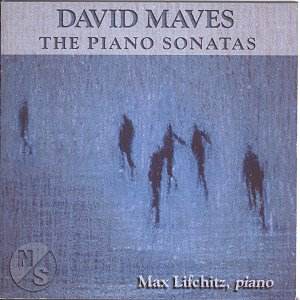David Maves’ four piano sonatas span some twenty years
of his composing career and thus provide for a good opportunity to assess
his musical progress over the years.
The Piano Sonata No.1 (1973) has a somewhat
unusual structure and consists in six short sections, of which the first
five are best heard as studies in piano writing and piano sound. The
final section Finale summarises and amplifies the various, rather
disparate elements of the preceding sections. The piano writing here
is somewhat more radical and ‘modern’ than in the later sonatas, but
never extravagantly so.
The Piano Sonata No.2 (1978) is rather
similar to the First in that it is also a multi-sectional piece of which
the last section Sonata is some sort of summation of the preceding ones,
much in the same way but on a somewhat larger scale than in the First
Sonata. The major difference is that the Second Piano Sonata is in fact
a theme and variations capped by a larger Finale, and the composer acknowledges
Beethoven’s Diabelli Variations as a model. A fairly impressive
piece of music, I must say, and a very taxing one, from the pianist’s
point of view.
The composer admits that his Piano Sonata No.3
(1993) is a "simple, straightforward Neo-classical sonata".
To some extent this is a fairly apt description of the piece, obviously
on a smaller scale than the Second and in a comparatively more traditional
idiom, thought I doubt that ‘Neo-classical’ is the right word to describe
the music. On the whole, however, the Third Sonata is a quite accessible
and enjoyable piece of music well worth having.
In total contrast again, the Piano Sonata No.4
(1994) is on a rather grand scale and is laid-out in four movements,
thus roughly adhering to the traditional sonata pattern. The opening
movement is full of vitality and grand, brilliant gestures, and must
be rather tricky to play. The following Andante is a theme and
variations, and is followed by a nervous Scherzo. The Fourth Piano Sonata
ends in grand manner, "a gargantuan build-up for its entire length
into a big ending". The Fourth Sonata is an expansive work
in the mould of the big romantic sonata, though the music is somewhat
more traditional though still clearly 20th Century, and quite
demanding, calling for much strength and stamina on the performer’s
part.
Maves’ piano sonatas are really fine, beautifully written
and very contrasted works. In a way, a composer’s view on 20th
Century piano writing in all its diversity while clearly avoiding the
more ‘trendy’ gimmicks. Even if parts of the earlier sonatas are somewhat
more ‘modern’ in sound, the music is very accessible, often rather demanding
but always very rewarding.
Besides being the founder and conductor of the North/South
Consonance ensemble, Max Lifschitz is also a brilliant pianist who has
the full measure of Maves’ often intricate music. The present recording
of the first two sonatas was originally released on OPUS ONE RECORDS
and are cleanly transferred here, whereas the recordings of the Third
and Fourth Sonatas were made in 1995 and were given a warm, natural
piano sound. Well worth investigating.
Hubert Culot


